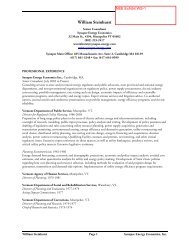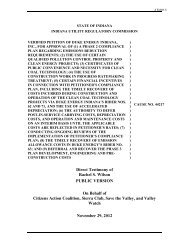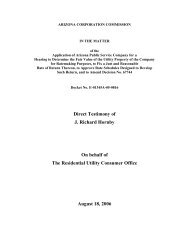Best Practices in Energy Efficiency Program Screening - Synapse ...
Best Practices in Energy Efficiency Program Screening - Synapse ...
Best Practices in Energy Efficiency Program Screening - Synapse ...
You also want an ePaper? Increase the reach of your titles
YUMPU automatically turns print PDFs into web optimized ePapers that Google loves.
5. <strong>Efficiency</strong> Screen<strong>in</strong>g Methodological Issues<br />
5.1 Discount Rate<br />
The choice of discount rate to use for calculat<strong>in</strong>g present values of costs and benefits<br />
has significant implications for the cost-effectiveness of energy efficiency programs,<br />
because program costs are typically <strong>in</strong>curred <strong>in</strong> the first years while program benefits are<br />
enjoyed for the life of the energy efficiency measure. This section describes the<br />
rationale for which discount rate should be applied when screen<strong>in</strong>g energy efficiency<br />
programs, for each of the standard cost-effectiveness tests.<br />
The Goal of Discount<strong>in</strong>g<br />
F<strong>in</strong>ancial analysis of <strong>in</strong>vestments <strong>in</strong> energy efficiency should account for the fact that an<br />
energy efficiency <strong>in</strong>itiative typically consists of an upfront <strong>in</strong>vestment <strong>in</strong> a structure or an<br />
end-use piece of equipment, which is expected to provide returns, <strong>in</strong> the form of energy<br />
sav<strong>in</strong>gs, over a number of years. In order to compare costs and benefits that occur over<br />
a number of years, the various cash flows (i.e., the <strong>in</strong>itial <strong>in</strong>vestment and the annual<br />
sav<strong>in</strong>gs over the measure life) must be compared <strong>in</strong> a consistent way, usually as a<br />
present value expressed <strong>in</strong> the dollars of a common reference year.<br />
There is noth<strong>in</strong>g special about energy efficiency <strong>in</strong> this regard; this challenge exists for<br />
analyz<strong>in</strong>g any long-lived <strong>in</strong>vestment. Economic and f<strong>in</strong>ancial theory generally<br />
acknowledge that a monetary benefit provided <strong>in</strong> a given year is more valuable than the<br />
same monetary value delivered <strong>in</strong> a later year.<br />
There are three commonly accepted reasons for this. One is <strong>in</strong>flation, which almost<br />
always causes a dollar <strong>in</strong> a future year to have less purchas<strong>in</strong>g power than a dollar <strong>in</strong> an<br />
earlier year. The second reason is time preference; economic theory holds that people<br />
simply value benefits <strong>in</strong> the present more than the same benefit <strong>in</strong> the future, at least<br />
with respect to monetary benefits. The farther out <strong>in</strong> the future an expected benefit, the<br />
more such a person would prefer a present benefit. The third reason is risk; future<br />
monetary benefits from an <strong>in</strong>vestment are rarely guaranteed. The promise of a<br />
monetary benefit <strong>in</strong> a future year has less value than an actual monetary benefit <strong>in</strong> the<br />
current year due to the risk that the future benefit may not occur or may be less than<br />
expected.<br />
Account<strong>in</strong>g for Inflation<br />
This part of the discount<strong>in</strong>g is relatively straightforward, and requires a forecast of<br />
<strong>in</strong>flation rates for the term of the project life. One option is to use an econometric<br />
forecast, e.g., from an economic forecast<strong>in</strong>g firm. Another common approach is to use<br />
the historical long-term <strong>in</strong>flation rate or the average <strong>in</strong>flation rate for a period of recent<br />
years. Either way, the assumed <strong>in</strong>flation rate can be used to turn each year’s costs and<br />
sav<strong>in</strong>gs <strong>in</strong>to so-called “real dollars” or “constant dollars.” Typically, a project’s start year<br />
or a base year for a utility’s other forecast<strong>in</strong>g efforts would be chosen.<br />
The choice of whether to use a “real” discount rate or a “nom<strong>in</strong>al” discount rate depends<br />
upon the <strong>in</strong>flation assumptions that are used <strong>in</strong> the annual costs and benefits of the<br />
efficiency cost-effectiveness analysis. It is important that consistent assumptions are<br />
| 50 <strong>Best</strong> <strong>Practices</strong> <strong>in</strong> <strong>Energy</strong> <strong>Efficiency</strong> <strong>Program</strong> Screen<strong>in</strong>g | www.nhpci.org







